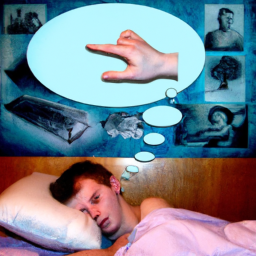As someone who has experienced intense and occasionally disturbing dreams while taking Prozac, I can relate to those seeking ways to minimize these side effects. Prozac, a commonly prescribed antidepressant that has helped many in their struggle with mental health, can unfortunately sometimes cause disturbing dream abnormalities.
It’s important to note that not everyone experiences Prozac dreams, and they may vary in intensity from person to person. However, for those who do experience them, it’s understandable to want relief.
In this article, we’ll explore various strategies for stopping Prozac dreams and improving overall sleep quality. Remember to always consult with your doctor before making any changes to your medication or treatment plan.
Key Takeaways
- Good sleep hygiene habits can improve sleep quality and potentially reduce the intensity of Prozac dreams.
- Relaxation techniques such as meditation, deep breathing, and progressive muscle relaxation can alleviate stress and anxiety.
- Herbal supplements like melatonin, valerian root, or chamomile can help reduce Prozac dreams.
- Coping strategies such as identifying triggers and seeking support from loved ones or healthcare professionals can help reduce the frequency and intensity of Prozac-induced dreams.
Understanding Prozac Dreams
You’re probably wondering why Prozac dreams happen and how they’re related to your medication. Understanding dream analysis can help you make sense of these vivid, sometimes unsettling experiences that occur when taking antidepressants like Prozac.
These dreams may be a result of the changes in brain chemistry that occur with medication, or they may be linked to anxiety and stress. Coping with anxiety during medication is important not only for managing Prozac dreams but also for overall mental health.
It’s essential to find healthy ways to manage stress, such as exercise, meditation, or therapy. Additionally, talking openly with your doctor about any concerns or side effects can help alleviate anxiety and provide guidance on how to handle unwanted symptoms.
With understanding and support from both yourself and your healthcare provider, it’s possible to manage Prozac dreams and experience the benefits of this medication without added stress.
Talk to Your Doctor
Isn’t it ironic that the one person who prescribed you Prozac dreams is also the only one who can help you put an end to them? Talking to your doctor about your medication dosage and discussing alternative treatments can be a crucial step in reducing or eliminating these vivid dreams.
It’s important to remember that everyone’s body reacts differently to medication, so what works for someone else may not work for you. Your doctor may suggest adjusting your Prozac dosage or switching to a different medication altogether. They may also recommend incorporating alternative treatments such as therapy, meditation, or exercise into your routine.
While it may take some trial and error to find the right solution for you, communicating openly with your doctor is key in finding relief from these unsettling dreams. With that being said, improving sleep hygiene can also play a significant role in stopping Prozac dreams.
Let’s explore some tips and tricks for creating a peaceful sleeping environment next.
Improve Sleep Hygiene
To improve your quality of sleep and potentially reduce the intensity of vivid dreams, it’s important to prioritize good sleep hygiene habits. One way to do this is by establishing a consistent bedtime routine. This can include activities such as taking a warm bath or shower, reading a book, or practicing relaxation techniques like deep breathing. By sticking to a routine before bed, your body will begin to associate these activities with sleep time, making it easier for you to fall asleep and stay asleep.
Another important aspect of good sleep hygiene is minimizing screen time before bed. The blue light emitted by electronic devices such as phones and laptops can disrupt your body’s natural circadian rhythm, making it harder for you to fall asleep and potentially exacerbating any vivid dream experiences. Instead, try reading a physical book or engaging in calming activities that don’t involve screens in the hour leading up to bedtime. By prioritizing these habits, you may find that your overall quality of sleep improves and that any intense dreams become less frequent.
Transitioning into the subsequent section about exercise: Incorporating regular exercise into your daily routine can also have a positive impact on both the quantity and quality of your sleep.
Exercise
Incorporating regular exercise into your daily routine can be a game-changer for improving the quality of your sleep and potentially reducing the intensity of vivid dreams. Exercise has numerous benefits, including helping you fall asleep faster, improving deep sleep, and reducing stress levels.
Additionally, when we exercise, our body temperature increases and then decreases during post-exercise recovery. This drop in temperature signals to the brain that it’s time to rest and recover.
There are various types of exercises you can do to improve your sleep hygiene. You could try cardio exercises such as running or cycling which can help reduce stress levels and tire out the body physically. Yoga is another form of exercise that can help calm the mind and relax the body before bedtime.
Incorporating a mix of both types into your daily routine may lead to better overall sleep quality. In the next section, we will explore relaxation techniques that can further aid in achieving peaceful slumber without resorting to medication or supplements.
Relaxation Techniques
I’d like to talk about some relaxation techniques that can help alleviate stress and anxiety.
Meditation, deep breathing, and progressive muscle relaxation are all effective ways to calm the mind and body.
By taking a few minutes each day to practice these techniques, you may find that you feel more centered and better able to cope with daily challenges.
Meditation
By focusing on your breath and letting go of any distracting thoughts, meditation can be a powerful tool to reduce the intensity of Prozac dreams. Meditation benefits the mind and body by reducing stress, anxiety, and depression.
There are different meditation techniques that you can try such as mindfulness meditation, guided visualization, mantra meditation, or movement meditation. Mindfulness meditation is a type of meditation that involves paying attention to the present moment without judgment. Guided visualization is a technique where you imagine peaceful scenes or pleasant images in your mind. Mantra meditation involves repeating a word or phrase silently to yourself during your practice. Movement meditation incorporates physical movement into your meditative practice like yoga or tai chi.
By incorporating one of these techniques into your daily routine, you may find relief from your Prozac dreams and improve overall well-being. To further reduce the intensity of Prozac dreams, deep breathing exercises can also be helpful.
Deep Breathing
Meditation is a powerful tool to calm the mind and reduce stress, but it may not always be effective in stopping Prozac dreams. In such cases, deep breathing can be a useful alternative. Breathing techniques and mindfulness exercises have been shown to help individuals relax and improve their quality of sleep.
One simple technique involves inhaling deeply through the nose for a count of four, holding the breath for a count of seven, then exhaling slowly through the mouth for a count of eight. This pattern can be repeated several times until one feels more relaxed. Another method is to focus on one’s breath and observe each inhalation and exhalation without judgment or distraction. These practices can help individuals become more aware of their body sensations and allow them to let go of any tension or anxiety that may contribute to Prozac dreams.
| Pros | Cons |
|---|---|
| Can be done anywhere | May take time to see results |
| Easy to learn | May require practice |
| Free | Requires discipline |
Using deep breathing techniques as part of your daily routine can lead to significant improvements in your overall well-being. By incorporating mindfulness exercises into our lives, we become more present in the moment and better equipped to manage stressors that could trigger unwanted side effects such as Prozac dreams. If you find that deep breathing alone does not provide enough relief from your symptoms, try progressive muscle relaxation as an additional strategy towards improving your sleep quality.
Progressive Muscle Relaxation
To ease muscle tension and promote relaxation, you can try progressive muscle relaxation (PMR). This technique involves tensing and relaxing different muscle groups in your body systematically. Here are some benefits of PMR:
- Reduces muscle tension and pain
- Decreases anxiety and stress levels
- Improves sleep quality
- Enhances overall physical and mental health
There are different types of PMR techniques that you can try. One common method involves tensing a specific muscle group for 5 to 10 seconds before releasing the tension completely. Another technique is focusing on the sensation of relaxation that comes after releasing the tension. You can also combine breathing exercises with PMR for better results.
In addition to practicing PMR, making dietary changes can also help reduce prozac dreams. By avoiding caffeine, alcohol, and processed foods before bedtime, you can improve your sleep quality and minimize any disruptive dreams or nightmares.
Dietary Changes
Switching up your diet may help reduce the intensity of Prozac dreams. Healthy eating and lifestyle changes can have a positive impact on our overall well-being, including our sleep quality. It’s important to focus on incorporating nutrient-dense foods such as whole grains, fruits and vegetables, lean proteins, and healthy fats into your diet while limiting processed foods and sugar.
In addition to making healthier food choices, it’s also important to pay attention to when you eat. Going to bed on an empty stomach or consuming heavy meals close to bedtime can disrupt your sleep cycle and increase the likelihood of vivid dreams.
By making these dietary changes, you may be able to improve the quality of your sleep and ultimately reduce the intensity of Prozac dreams.
Making dietary changes is just one step in managing Prozac dreams. Another option is incorporating herbal supplements into your daily routine for additional support.
Herbal Supplements
I’ve personally experienced the vivid and disturbing dreams that can come with taking Prozac, so I understand the desire to find alternative solutions.
One option is to try herbal supplements like melatonin, valerian root, or chamomile.
Melatonin has been shown to improve sleep quality and regulate sleep cycles, while valerian root can reduce anxiety and promote relaxation.
Chamomile is also known for its calming effects and may help alleviate insomnia.
As always, it’s important to talk to your doctor before starting any new supplement regimen.
Melatonin
You can try taking melatonin supplements to help regulate your sleep cycle and reduce vivid dreams while on Prozac. Melatonin is a natural hormone that helps regulate sleep-wake cycles, making it a popular alternative to prescription sleep aids. It’s also available over-the-counter and considered safe for most people.
To use melatonin as a sleep aid, take it 30 minutes before bedtime at the same time each night. Start with a low dose (0.5-1 mg) and gradually increase if needed. Keep in mind that melatonin may interact with other medications, so check with your doctor before using it. While melatonin has been shown to improve sleep quality and reduce nightmares, some people may experience side effects such as headaches or dizziness.
If you’re looking for another natural alternative to sleep aids, valerian root is worth considering. It’s an herb that has been used for centuries as a sedative and anxiety reducer.
In the next section, we’ll discuss how valerian root can be used to promote relaxation and improve sleep while on Prozac.
Valerian Root
Consider adding valerian root to your routine to promote a sense of calm and relaxation, allowing for a more restful sleep. Valerian root is an herbal supplement that’s been used for centuries as a natural remedy for anxiety and insomnia. It contains compounds that interact with the brain’s GABA receptors, which helps reduce stress and anxiety levels.
Valerian root benefits extend beyond its calming properties; it can also improve sleep quality by increasing the amount of time spent in deep sleep stages. However, it’s important to note that dosing is crucial when taking this supplement. The recommended dose is 300-600mg taken about an hour before bedtime. It’s best to start with a lower dosage and gradually increase until you find the right amount for you.
Moving on to chamomile, this herb has also been shown to have relaxing effects on the body and mind.
Chamomile
Chamomile is a great option for those looking to unwind before bedtime, with its relaxing effects on both the body and mind. This herb has been used for centuries as a natural remedy for sleeplessness and anxiety, making it an ideal choice for those who want to avoid prescription medication like Prozac. Chamomile benefits include reducing stress levels, calming nerves, and promoting restful sleep. The best part about chamomile is that it’s easy to incorporate into your routine – simply brew a cup of chamomile tea before bed or take it in supplement form.
When it comes to dosage, there are different options depending on your preference. For tea, steep one or two teaspoons of dried chamomile flowers in boiling water for 5-10 minutes. Drink this infusion about half an hour before you go to bed. If you prefer supplements, follow the recommended dosage on the packaging or talk to your doctor first if you’re uncertain about how much to take. Keep in mind that while chamomile may help with Prozac dreams, it’s not a cure-all solution and should be used as part of a holistic approach that includes healthy habits like exercise and cognitive behavioral therapy.
Transitioning into the subsequent section about ‘cognitive behavioral therapy’, we can explore additional ways to address Prozac dreams beyond herbal remedies alone.
Cognitive Behavioral Therapy
I’ve found that Cognitive Behavioral Therapy (CBT) can be effective in addressing underlying issues that may contribute to mental health struggles. Through CBT, I’ve learned how to develop coping strategies that help me manage stress and anxiety in a healthier way.
Additionally, CBT has helped me improve my sleep quality by identifying and addressing any negative thought patterns or behaviors that may interfere with restful sleep.
Addressing Underlying Issues
You need to identify the root cause of your anxiety and address it in order to stop experiencing vivid dreams while taking Prozac. Sometimes, the vivid dreams are a sign that there is an underlying issue that needs to be addressed. This could be anything from past trauma or unresolved conflicts, to current stressors in your life.
One way to address these issues is by seeking support from a therapist or counselor. They can help you work through any emotional blocks or past traumas that may be contributing to your anxiety and vivid dreams. By addressing these underlying issues, you may find that the intensity of your dreams decreases over time.
In addition, developing coping strategies can also help reduce the frequency and intensity of Prozac-induced dreams.
Developing Coping Strategies
Finding ways to navigate through the vivid dreams caused by medication is like navigating through a stormy sea, but there are coping strategies that can help ease the turbulence. One effective strategy is identifying triggers that may be contributing to the vivid dreams. This could include factors such as consuming caffeine or alcohol before bed, not getting enough exercise during the day, or experiencing stress and anxiety in daily life. By pinpointing these triggers, you can take steps to eliminate them or reduce their impact on your sleep.
Another important coping strategy is seeking support from loved ones or a healthcare professional. Talking about your experiences with someone who understands and cares about you can provide emotional relief and practical advice for managing your symptoms. A mental health professional may also be able to offer additional guidance and resources for dealing with medication-induced dreams. With patience and perseverance, incorporating these coping strategies into your routine can help you feel more in control of your sleep quality and overall well-being.
Transition: While addressing underlying issues and developing coping strategies can go a long way toward easing Prozac-related dreams, improving sleep quality is another key component of achieving restful nights.
Improving Sleep Quality
Developing coping strategies is a crucial step in managing Prozac dreams, but sometimes it may not be enough. In such cases, improving sleep quality becomes the next necessary step.
One way to do this is by sleep tracking, which involves monitoring your sleep patterns using wearable devices or mobile applications. This can provide insights into what affects your sleep and help identify any potential issues that need addressing.
Another important aspect of improving sleep quality is having a consistent bedtime routine. This can involve winding down before bed, avoiding screens for at least an hour before sleeping, and creating a relaxing environment in your bedroom. These habits signal to our bodies that it’s time to rest and can help us fall asleep faster and stay asleep longer.
By prioritizing good sleep hygiene practices like these, we give ourselves the best chance of reducing the frequency and intensity of Prozac dreams.
It’s frustrating when you’re doing everything right but still struggling with poor sleep. Feeling tired all day can affect productivity and mood. Incorporating healthy habits into our daily routines can take effort but pays off in the long run. Setting aside time for self-care helps us show up fully for ourselves and others.
Improving our sleep quality is just one piece of the puzzle in managing Prozac dreams; mindfulness-based stress reduction is another helpful tool to explore.
Mindfulness-Based Stress Reduction
When I struggled with sleep issues, one approach that helped me was practicing mindfulness-based stress reduction. This technique involves learning to be present in the moment, accepting thoughts and feelings without judgment, and focusing on breathing or other calming techniques.
Taking control of my sleep meant finding what worked for me, whether it was a specific routine or relaxation method. However, if these methods don’t work or if sleep problems persist, it’s important to seek help from a healthcare professional who can provide further guidance.
Taking Control of Your Sleep
To take control of your sleep, you need to prioritize relaxation and create a calming bedtime routine that will help you achieve peaceful rest. Here are five tips on how to do just that:
- Turn off electronic devices at least an hour before bed.
- Dim the lights in your bedroom and set the temperature to a comfortable level.
- Take a warm bath or shower before getting into bed.
- Practice relaxation techniques such as deep breathing or meditation.
- Read a book or listen to calming music before drifting off.
By incorporating these steps into your nightly routine, you can create an environment that promotes healthy sleep habits.
It may take some trial and error to find what works for you, but prioritizing relaxation and consistency is key. With time and effort, you can say goodbye to Prozac dreams and hello to restful nights.
Finding What Works for You
You can experiment with different relaxation techniques and bedtime routines until you find the perfect combination that allows you to easily slip into a peaceful slumber.
Some people find that listening to calming music or white noise helps them relax, while others prefer reading a book or taking a warm bath before bed.
Breathing exercises and meditation can also be effective in quieting the mind and promoting relaxation.
Exploring alternatives and experimenting with techniques is key in finding what works best for you. It may take some trial and error, but don’t give up hope. With patience and persistence, you can discover the right combination of sleep hygiene practices that will help reduce prozac dreams.
However, if implementing these strategies doesn’t improve your sleep quality, it may be time to seek additional assistance from a healthcare professional.
When to Seek Help
If you’re struggling to improve your sleep quality despite trying various relaxation techniques and bedtime routines, it may be beneficial to seek assistance from a healthcare professional. Prozac dreams can be a possible side effect of taking the medication, and they may interfere with your ability to get restful sleep.
If these dreams are causing distress or affecting your daily life, it’s important to talk to your doctor about adjusting your medication or exploring other treatment options. Additionally, if you’ve been experiencing other symptoms such as mood changes, anxiety, or difficulty concentrating, it could indicate a larger issue that requires medical attention.
Your healthcare provider can help determine the underlying cause of these symptoms and develop a personalized plan for managing them. Remember that seeking medical advice isn’t a sign of weakness but rather a proactive step towards improving your overall health and well-being.
Frequently Asked Questions
What are some common side effects of taking Prozac?
As someone who has taken Prozac, I know firsthand that common side effects include nausea, headaches, and decreased libido. Managing side effects can involve tips like staying hydrated and getting enough rest. Alternative medication options may also be worth exploring with your doctor.
Can Prozac dreams be dangerous?
Are Prozac dreams dangerous? While they may cause some discomfort, they are not typically harmful. If they persist or become unbearable, seeking medical intervention or coping strategies such as relaxation techniques may be helpful.
How long do Prozac dreams typically last?
Based on duration analysis, prozac dreams typically last for a few weeks to a month. Coping mechanisms like journaling or talking with a therapist can help manage any discomfort they may cause. It’s important to discuss any concerns with your healthcare provider.
Can Prozac dreams be a sign of a larger issue?
Prozac dreams may indicate underlying conditions, such as anxiety or depression. Treatment options include adjusting medication dosages or switching to a different medication. It’s important to discuss any concerns with a healthcare provider for personalized care.
Is it safe to abruptly stop taking Prozac?
Abruptly stopping Prozac can result in withdrawal symptoms, including anxiety and insomnia. Gradual tapering is safe and recommended to minimize discomfort. Remember, seeking medical advice is important when making any changes to medication.
Conclusion
As I lay in bed, tossing and turning, trying to shake off the vivid dreams that Prozac seemed to bring on every night, I felt frustrated and exhausted.
But after researching and implementing various strategies, I finally found relief from these disturbing dreams. It was like finding a hidden treasure in an old chest – the key was understanding what caused the dreams and taking action to address them.
By talking with my doctor and incorporating healthy habits such as exercise, relaxation techniques, dietary changes, herbal supplements, cognitive behavioral therapy, and mindfulness-based stress reduction into my routine, I was able to conquer my Prozac-induced nightmares once and for all.
And just like that treasure chest brought me joy and satisfaction, so did overcoming this obstacle in my life.
If you are struggling with Prozac dreams or any other side effect of medication, know that you’re not alone. With determination and guidance from healthcare professionals, there is hope for relief.
Remember to take care of yourself – physically, emotionally, and mentally – just like you would if you were searching for a valuable prize. In doing so, your journey towards healing can be one filled with success rather than despair.










